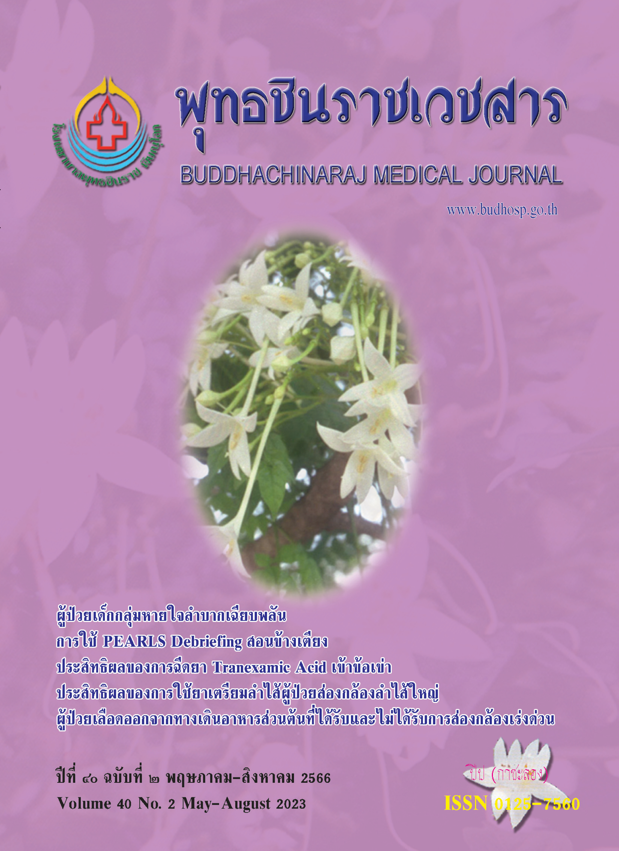ข้อมูลทางคลินิกและปัจจัยเสี่ยงต่อการเสียชีวิตในผู้ป่วยเด็กกลุ่มอาการหายใจลำบากเฉียบพลันdiatric Acute Respiratory Distress Syndrome
ผู้ป่วยเด็กกลุ่มอาการหายใจลำบากเฉียบพลัน
คำสำคัญ:
โรคถุงลมปอดอักเสบเฉียบพลันในเด็ก, ข้อมูลทางคลินิก, ปัจจัยเสี่ยงต่อการเสียชีวิตบทคัดย่อ
กลุ่มอาการถุงลมปอดอักเสบเฉียบพลันในเด็ก (PARDS) เป็นโรคที่มี ความรุนแรงและมีอัตราการเสียชีวิตสูง แนวทางการให้การวินิจฉัยและ การรักษาโรคได้ปรับปรุงมาเป็นระยะจนได้ออกแนวปฏิบัติเฉพาะของผู้ ป่วยเด็กใน พ.ศ. 2558 ในนาม PALICC 2015 ซึ่งเป็นที่ยอมรับและ ปฏิบัติตามระดับสากล การศึกษาแบบย้อนหลังนี้มีวัตถุประสงค์เพื่อ วิเคราะห์ข้อมูลทางคลินิกและปัจจัยเสี่ยงต่อการเสียชีวิตของผู้ป่วย PARDS ในโรงพยาบาลพุทธชินราช พิษณุโลก ระหว่างวันที่ 1 มกราคม พ.ศ. 2559 ถึงวันที่ 31 ธันวาคม พ.ศ. 2563 พบมีผู้ป่วย PARDS 53 ราย เป็นเพศชาย 32 ราย (ร้อยละ 60.4) มีสาเหตุการเกิดโรคจากการบาด เจ็บต่อถุงลมปอดโดยตรง 47 ราย (ร้อยละ 88.7) มีอัตราการเสียชีวิตใน 28 วัน (เฉลี่ย 5 ปี) ร้อยละ 52.8 โดยปัจจัยที่มีผลต่อการเสียชีวิต ได้แก่ ระดับความรุนแรงของโรคซึ่งพิจารณาจาก OI และ OSI, คะแนน PRISM III, คะแนน PELOD-2, การมีอวัยวะภายในล้มเหลวโดยเฉพาะ ภาวะลิ่มเลือดแพร่กระจายในหลอดเลือดและภาวะช็อกจากการติดเชื้อ ในกระแสเลือด, ระดับ lactate ในเลือด และปริมาณยากระตุ้นความดัน โลหิตที่ใช้ สรุปได้ว่าผู้ป่วย PARDS ในโรงพยาบาลนี้มีอัตราการเสียชีวิต สูงใกล้เคียงกับกลุ่มประเทศกำลังพัฒนา ผู้ป่วยที่พบปัจจัยเสี่ยงดังกล่าว ควรได้รับการติดตามอย่างใกล้ชิดหรือพิจารณาการรักษาทางเลือกเพิ่ม เติม
เอกสารอ้างอิง
Bernard GR, Artigas A, Brigham KL, Carlet J, Falke K, Hudson L, et al. The American-European Consensus Conference on ARDS. definitions, mechanisms, relevant outcomes and clinical trial coordination. Am J Respir Crit Care Med 1994;149(3 Pt 1):818-24.
Ranieri VM, Rubenfeld GD, Thompson BT, Ferguson ND, Caldwell E, Fan E, et al. Acute respiratory distress syndrome: the Berlin Definition. JAMA 2012;307(23):2526-33.
Yehya N, Thomas NJ. Relevant outcomes in pediatric acute respiratory distress syndrome studies. Front Pediatr 2016;4:00051. https://doi.org/10.3389/fped.2016.00051
Pediatric Acute Lung Injury Consensus Conference G. Pediatric acute respiratory distress syndrome: consensus recommendations from the Pediatric Acute Lung Injury Consensus Conference. Pediatr Crit Care Med 2015;16(5):428-39.
Wong JJ, Jit M, Sultana R, Mok YH, Yeo JG, Koh J, et al. Mortality in pediatric acute respiratory distress syndrome: a systematic review and meta-analysis. J Intensive Care Med 2019;34(7):563-71.
Dowell JC, Parvathaneni K, Thomas NJ, Khemani RG, Yehya N. Epidemiology of cause of death in pediatric acute respiratory distress syndrome. Crit Care Med 2018;46(11):1811-9.
Kelsey S, Lisa H. Emergency and critical care management. In: Keith K, Lauren M, Matthew M, editors. The Harriet Lane Handbook. 22nd ed. Philadelphia, Pensylvania State, USA: Elsevier;2021. p.2-32.
Leteurtre S, Duhamel A, Salleron J, Grandbastien B, Lacroix J, Leclerc F. PELOD-2: an update of the PEdiatric logistic organ dysfunction score. Crit Care Med 2013;41(7):1761-73.
Pollack MM, Patel KM, Ruttimann UE. PRISM III: an updated Pediatric Risk of Mortality score. Crit Care Med 1996;24(5):743-52.
Rsovac S, Plavec D, Todorovic D, Lekovic A, Scepanovic T, Malinic M, et al. PRISM III score predicts short-term outcome in children with ARDS on conventional and high-frequency oscillatory ventilation. Children (Basel) 2022;10(1):1-10.
McIntosh AM, Tong S, Deakyne SJ, Davidson JA, Scott HF. Validation of the vasoactive-inotropic score in pediatric sepsis. Pediatr Crit Care Med 2017;18(8):750-7.
Yadav B, Bansal A, Jayashree M. Clinical profile and predictors of outcome of pediatric acute respiratory distress syndrome in a PICU: a prospective observational study. Pediatr Crit Care Med 2019;20(6):e263-73.
Gupta S, Sankar J, Lodha R, Kabra SK. Comparison of prevalence and outcomes of pediatric acute respiratory distress syndrome using Pediatric Acute Lung Injury Consensus Conference criteria and Berlin definition. Front Pediatr 2018;6:93. doi: 10.3389/fped.2018.00093
Orloff KE, Turner DA, Rehder KJ. The current state of pediatric acute respiratory distress syndrome. Pediatr Allergy Immunol Pulmonol 2019;32(2):35-44.
Prasertsan P, Anuntaseree W, Ruangnapa K, Saelim K, Geater A. Severity and mortality predictors of pediatric acute respiratory distress syndrome according to the Pediatric Acute Lung Injury Consensus Conference Definition. Pediatr Crit Care Med 2019;20(10):e464-72.
Emeriaud G, López-Fernández YM, Iyer NP, Bembea MM, Agulnik A, Barbaro RP, et al. Executive summary of the Second International Guidelines for the diagnosis and management of pediatric acute respiratory distress syndrome (PALICC-2). Pediatr Crit Care Med 2023;24(2):143-68.
Jayashree M, Vishwa CR. HFOV in Pediatric ARDS: Viable or vestigial? Indian J Pediatr 2020;87(3):171-2.
Balcarcel DR, Coates BM, Chong G, Sanchez-Pinto LN. Excessive oxygen supplementation in the first day of mechanical ventilation is associated with multiple organ dysfunction and death in critically ill children. Pediatr Crit Care Med 2022;23(2):89-98.
ดาวน์โหลด
เผยแพร่แล้ว
ฉบับ
ประเภทบทความ
สัญญาอนุญาต
ลิขสิทธิ์ (c) 2023 ``โรงพยาบาลพุทธชินราช พิษณุโลก

อนุญาตภายใต้เงื่อนไข Creative Commons Attribution-NonCommercial-NoDerivatives 4.0 International License.






